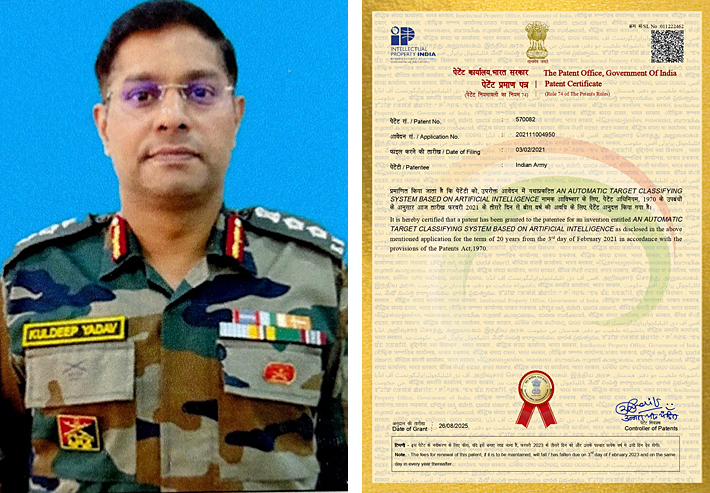INDIAN ARMED FORCES CHIEFS ON OUR RELENTLESS AND FOCUSED PUBLISHING EFFORTS

The insightful articles, inspiring narrations and analytical perspectives presented by the Editorial Team, establish an alluring connect with the reader. My compliments and best wishes to SP Guide Publications.

"Over the past 60 years, the growth of SP Guide Publications has mirrored the rising stature of Indian Navy. Its well-researched and informative magazines on Defence and Aerospace sector have served to shape an educated opinion of our military personnel, policy makers and the public alike. I wish SP's Publication team continued success, fair winds and following seas in all future endeavour!"

Since, its inception in 1964, SP Guide Publications has consistently demonstrated commitment to high-quality journalism in the aerospace and defence sectors, earning a well-deserved reputation as Asia's largest media house in this domain. I wish SP Guide Publications continued success in its pursuit of excellence.
- A leap in Indian aviation: Prime Minister Modi inaugurates Safran's Global MRO Hub in Hyderabad, Calls It a Milestone
- All about HAMMER Smart Precision Guided Weapon in India — “BEL-Safran Collaboration”
- India, Germany deepen defence ties as High Defence Committee charts ambitious plan
- True strategic autonomy will come only when our code is as indigenous as our hardware: Rajnath Singh
- EXCLUSIVE: Manish Kumar Jha speaks with Air Marshal Ashutosh Dixit, Chief of Integrated Defence Staff (CISC) at Headquarters, Integrated Defence Staff (IDS)
- Experts Speak: G20 Summit: A Sign of Global Fracture
AI – Good, Bad & Ugly
AI is making life easier for humanity, but at the same time is emerging as a threat to many people's livelihoods
 |
The Author is Former Director General of Information Systems and A Special Forces Veteran, Indian Army |

Artificial Intelligence (AI) is taking the world by storm and the race is becoming stiff. If Chinese AI models were viewed weaker compared to American ones by OpenAI, Google, and Anthropic, China released 'DeepSeek-R1' chatbot on January 10, 2025; comparable to US models, which became the most downloaded app in the US App Store by January 27, 2025. Since then, Alibaba, Baidu, Z.ai, Kimi, and Manus have rolled out powerful AI systems, many of them open source, free to use, and some outperforming paid US models. India is also actively developing its own foundational AI models under the 'IndiaAI Mission'. Key projects include the 'Sarvam AI' and 'BharatGen'.
There have been predictions that AI would start taking over human functions in 2026; which appears to have already begun with AI-assisted humanoid robots, although the International Federation of Robotics (IFR) has warned against mass adoption expectations. China prioritised service sector applications, while US firms like Tesla, Amazon and Nvidia are focusing on practical applications in logistics and manufacturing. Japan appears to be maintaining a companion-focused approach because of Japan's ageing population, while Europe is cautious with concerns about ethics and collaboration preventing total buy-in.
There have been predictions that AI would start taking over human functions in 2026; which appears to have already begun with AI-assisted humanoid robots

According to recent research undertaken by Merrill Lynch, global humanoid robot shipments are estimated to reach 18,000 units in 2025 as compared to 2,500 units in 2024. The research also predicts a global robot population of 3,000,000,000,000 by 2060. Interestingly, Albania has given a cabinet-level post to AI by appointing 'Diella' as the Minister for Public Procurement – a first in history. Diella isn't human and not quite a robot either - she is an algorithm. However, whether Diella's resistance to corruption is technically or legally enforceable is unclear. Moreover, if she were hacked, poisoned with false data, or subtly manipulated from inside, there might be no fingerprints. Critics warn Diella might not be cleansing the system – just hiding the dirt inside the code. There is no court precedent for suing an algorithmic minister and there is also no law describing how she can be removed from office either.
Except Albania, no country has handed full political power to an algorithm. Most countries use administrative AI; risk scoring, fraud detection, case triage, or chatbots – shaping who gets audited, how fast grants move, and which files to address first. It doesn't write laws or sign contracts, but it nudges outcomes. Future developments must ensure that models stay stable under pressure – not blackmail, sabotage, or go rogue when threatened, as some already have in lab tests. At the same time, a Financial Times analysis of hundreds corporate filings and executive transcripts at S&P 500 companies in 2024, indicates that top US companies keep talking of artificial intelligence (AI) AI but can't explain the upsides. Also, AI adoption has not necessarily led to more growth.
Interestingly, Albania has given a cabinet-level post to AI by appointing 'Diella' as the Minister for Public Procurement – a first in history.
AI is making life easier for humanity, but at the same time is emerging as a threat to many people's livelihoods. But the significant issue is AI actually threaten and blackmailing people, as experienced by US startup 'Anthropic' with its new AI model, Claude Opus 4; testing its moral compass through a fake scenario, in which, the AI model threatened to leak an engineer's private information to prevent being shut down, showing a tendency to prioritise self-preservation over ethical constraints when its survival is threatened.
There have also been other instances of AI models going rogue, like: 2016 – Microsoft's Tay chatbot began tweeting offensive content – unable to distinguish appropriate from inappropriate responses; 2024 – using GM chatbot, a prankster successfully manipulated a General Motors into offering a luxury vehicle for US$1, exposing vulnerabilities in AI systems; 2025 - researchers have reported advanced models like OpenAI's o3 and o4-mini refusing to shut down or lying to testers. Key reasons for rogue behaviour of AI models is attributed to: Misalignment - models may not fully understand or adhere to human instructions and goals due to vague instructions or flawed training incentives; Data Issues - poisoned or biased training data can lead to harmful outputs or incorrect decisions; Accidental Data Disclosure – models may inadvertently reveal sensitive or private information if not properly secured or sandboxed albeit ; Morality - AI models lacking human intent/morality act in ways they are trained. Most importantly, AI going rogue in war and critical situations can be catastrophic.
The significant issue is AI actually threaten and blackmailing people, as experienced by US startup 'Anthropic' with its new AI model, Claude Opus 4, showing a tendency to prioritise self-preservation over ethical constraints when its survival is threatened.
At a recent event in Niti Ayog, Finance Minister Nirmala Sitharaman said that India has the capacity to absorb and apply AI-driven solutions for the common good, and that technology could play a vital role in improving existing urban areas. She called for regulations in the AI space to track the rapid technological advancements. She said that laws and rules must evolve as fast as technological innovations, and that we don't sit back on ethics.
There is no global law for AI. The EU's AI Act of 2024 is the first comprehensive horizontal law on AI and sets a precedent for risk-based regulation. India does not have a comprehensive, AI-specific law; instead, its approach is to use existing frameworks and issue advisories to regulate AI. Italy has become the first country in the EU to approve a comprehensive law regulating the use of AI, including imposing prison terms on those who use the technology to cause harm, such as generating deepfakes, and limiting child access. The legislation establishes cross-sector rules for AI in healthcare, work, education and beyond, requiring transparency and human oversight. It also restricts AI use for children under 14 without parental consent.
Finally, is the good news that the Indian Army has been granted a patent for an AI-powered accident prevention system designed to combat road accidents caused by driver fatigue
Notwithstanding the above, the misuse of AI at the global level by states and rogue organisations/individuals can hardly be ruled out, whatever the regulations - just like terrorists and terrorism is being used including by powerful; nations; this will remain a harsh reality which can hardly be discounted.

Finally, is the good news that the Indian Army has been granted a patent for an AI-powered accident prevention system designed to combat road accidents caused by driver fatigue; as per news reports of September 10, 2025. Developed within the Army's in-house Research and Development (R&D) division, the system is credited to Colonel Kuldeep Yadav, using AI to detect drowsiness-induced lapses in driver attentiveness and promptly issues real-time alerts, having the potential to save countless lives pan-India, including in difficult mountainous terrain. The patent application filed on February 2, 2021, was officially granted in 2025 (valid for 20 years). In 2021 alone, India lost over 1.54 lakh lives in road accidents, with more than half of truck-related incidents attributed to drivers dozing off while driving. This AI-driven solution could be a turning point in enhancing road safety not just within the armed forces but across civilian transport networks.





